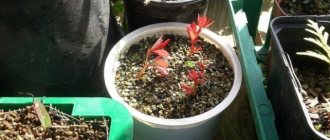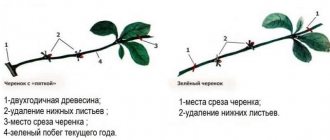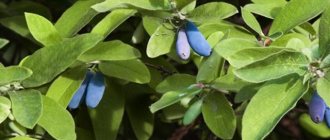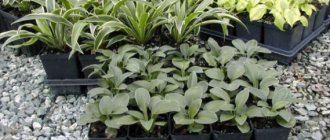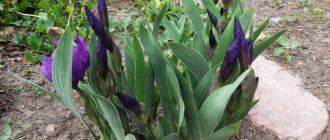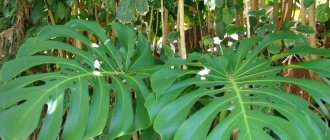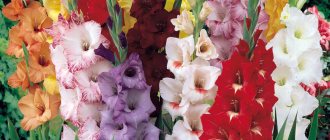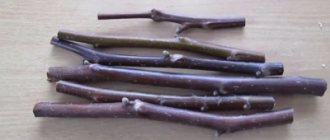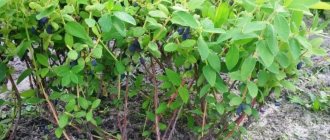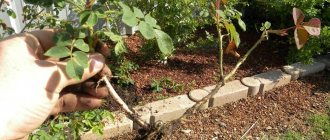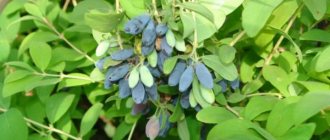Author: Natalya Category: Fruit and berry plants Published: August 09, 2015Republished: February 10, 2019Last edits: November 02, 2020
- When to plant
- Growing conditions
- When to prune
- Reproduction methods
- Beneficial features
plant (lat. Lonicera) is a type genus of the Honeysuckle family, represented by approximately two hundred species of climbing, creeping or erect shrubs. The Latin name was given to honeysuckle in honor of the German scientist Adam Lonitzer, although Carl Linnaeus preferred the name “honeysuckle” - it was honeysuckle honeysuckle (fragrant) that was most often grown in European gardens at that time. In nature, honeysuckle is common in the Northern Hemisphere, but most species of this plant grow in East Asia and the Himalayas. Today, both climbing honeysuckle, which is most often grown for vertical gardening, and garden honeysuckle, which is of interest both as an ornamental plant and as a source of tasty and healthy fruits, are cultivated in gardens.
Planting and caring for honeysuckle
- Planting: from spring to autumn, except May and June.
- Flowering: depending on the type and variety from June to September.
- Lighting: bright sun or partial shade.
- Soil: loose, drained, not too wet and not too poor soil.
- Watering: 2-3 times per season and only in extreme heat, water consumption - from 8 to 10 liters per bush.
- Feeding: if fertilizers were applied to the hole during planting, the plant will not need feeding for the first two years. Subsequently, in early spring and before flowering, solutions of complex mineral fertilizers are added to the soil. In summer, foliar feeding with urea and microelements is carried out. In the fall, wood ash is added to the tree trunk circle for digging.
- Pruning: sanitary pruning - in early spring, before the buds swell, or after leaf fall. Bushes that have reached 15 years of age undergo anti-aging pruning at the same time.
- Reproduction: seeds, layering, shoots and green cuttings.
- Pests: aphids, honeysuckle mites, scale insects, caterpillars of sawflies, leaf miners and moths, moths, herbivorous bugs, fingerwings.
- Diseases: ramulariasis, cercospora blight, powdery mildew, cucumber mosaic and rhinestone mosaic viruses.
Read more about growing honeysuckle below.
Proper planting of honeysuckle seedlings: what depth to keep?
The hole for planting shrubs must be prepared in advance, 2-3 weeks before planting. The recommended dimensions of the planting hole are 40 cm in width and depth. After digging, the pit must be filled with a fertile layer of soil, having previously fertilized it with fertilizers.
The hole is filled with the resulting soil to such a distance that the root collar of the bush is at ground level. After further backfilling and shaking of the cutting, it will drop by 5 cm - this will be the ideal depth for planting the bush.
Botanical description, species
In our gardens, along with such recognized berry crops as raspberries, strawberries, gooseberries and currants, in recent years strawberries, blueberries and blackberries, cultivated in the recent past, have appeared. And just recently we told you about the growing popularity of the actinidia plant. As for honeysuckle, mainly two types of garden honeysuckle are grown in cultivation - edible honeysuckle and blue honeysuckle, as well as numerous varieties based on these two species.
Edible honeysuckle (lat. Lonicera edulis)
An erect deciduous shrub about a meter high with young, thin, pubescent green shoots, tinged purple in some places. Old shoots are bare, up to three centimeters thick, covered with yellow-brown bark, which peels off in narrow strips. The crown of edible honeysuckle is spherical, dense, leaves are up to 7 cm long, oblong-lanceolate with round stipules. Young leaves, like young shoots, are densely pubescent; older leaves lose their pubescence completely or partially. Yellowish funnel-shaped flowers, located in pairs in the axils of the leaves, bloom in May or early June.
Edible honeysuckle fruits, from 9 to 12 mm long, dark blue with a bluish bloom, depending on the variety, have different shapes - round, elliptical, cylindrical. The pulp of honeysuckle fruits is red-violet, the seeds are dark brown, small - about 2 mm in size.
- Aralia
Blue honeysuckle, or blue honeysuckle (lat. Lonicera caerulea)
A woody deciduous plant reaching a height of two to two and a half meters. The shoots are erect, slightly curved, the crown is compact. The bark is brown with a gray or red tint, just as easily as the bark of edible honeysuckle, it is separated from the trunk in stripes. The leaves of blue honeysuckle are opposite, elliptical, almost sessile, up to 6 cm long, up to 3 cm wide. Pale yellow regular bell-shaped flowers are collected in inflorescences in the axils of several lower pairs of leaves. The fruit is a fragrant oblong elliptical berry of dark blue color with a bluish bloom and a bitter-sweet taste reminiscent of blueberries.
Honeysuckle grows quickly, lives and bears fruit for a long time - up to 80 years. Varieties of garden honeysuckle are self-fertile, so in order to wait for the fruits, you need to plant several different varieties in one area so that insect pollinators of honeysuckle can ensure their cross-pollination. In some areas, honeysuckle is the most important honey plant.
Planting honeysuckle
When to plant
You can plant honeysuckle from spring to autumn, but not in May or June - at this time honeysuckle has the most active growth of shoots. If you want to plant honeysuckle in the spring, then you need to do this before the buds open, and you should keep in mind that honeysuckle awakens very early. But it is still better to plant honeysuckle in the fall, from late September to mid-October. Before planting honeysuckle, choose the most comfortable place for growing it, bring the soil composition to the desired level, dig holes and prepare honeysuckle seedlings for planting.
A light, low-lying, swampy area, protected from the wind, is most suitable for honeysuckle - it can be located near a fence or surrounded by other bushes. The soil for honeysuckle is preferably fertile - loamy or sandy loam. Organic matter is added to poor soil, and if the soil pH in the area is shifted to the acidic side, add dolomite flour or chalk to the soil.
Before planting, the honeysuckle bush is carefully inspected, broken shoots and roots are removed, and roots that are too long are shortened to 30 cm in length.
How to plant
Planting of edible honeysuckle or any other is carried out in holes dug according to the 40x40x40 pattern, the distance between the holes is from a meter to two, depending on the type and variety of honeysuckle. 10-12 kg of well-rotted manure or humus, 100 g of double superphosphate, 300 g of wood ash, 30 g of potassium sulfate are added to the pit - all this is thoroughly mixed with fertile soil from the top layer and a mound is formed at the bottom of the pit, on which a honeysuckle bush is placed . Having straightened the roots of the plant, they are covered with loose soil. The root collar after planting should be at a depth of 3-5 cm.
Compact the soil around the seedling, make a border around it at a distance of 30 cm and pour a bucket of water onto the resulting area, and after the water is absorbed, mulch the soil around the bush with humus, peat or dry soil.
Dates for planting honeysuckle seedlings
The right time for planting honeysuckle in the spring is April . This should be done when the snow has completely melted, but the buds have not yet swelled . For example, in the middle zone (including the Moscow region) - you can plant in mid-April, in the South (Krasnodar Territory (Kuban), North Caucasus) - at the end of March, at the beginning of April, in Siberia, the Urals, in the Leningrad region - at the end of April, in the Volga region - the second ten days of April.
The optimal time for planting seedlings in the fall is late September to mid-October. In the South - in mid-October, in Siberia, the Urals, Leningrad region - mid-September, in the Moscow region - end of September.
In addition, you can choose the dates for autumn planting according to the Lunar calendar 2021:
- Favorable days: in September - 19, 20, 21, 22, 23, 24, 25, 26;
- in October - 3, 4, 5, 6, 7, 8, 9, 10, 11, 12, 13, 18, 19, 20, 21.
- in August - 4, 5, 19, 31;
Honeysuckle care
Growing conditions
How to grow honeysuckle in your garden and get a rich harvest of fruits? We hope that planting honeysuckle and caring for it will not seem difficult to you, since honeysuckle needs the same things that all other plants need - watering, weeding, loosening the soil around the bush, timely application of fertilizers, proper pruning and protection from pests and diseases. But keep in mind that the better you care for honeysuckle, the more elegant its bushes will be and the richer the harvest of berries will be.
Caring for honeysuckle is made easier by the fact that for the first three years after planting, the bush will only need to be hilled high in the spring, watered, loosened the soil and removed weeds around it, and if mulch is used, this will not have to be done often. There is no need to prune young plants. Water honeysuckle moderately, but in dry weather, especially in late spring and early summer, abundant watering is necessary, since lack of moisture causes honeysuckle to become bitter and the quality of the harvest may be at risk. If the weather is mild, without extreme heat and with regular moderate rains, water the honeysuckle 3-4 times per season, the amount of water poured under each bush at a time is 10 liters.
After watering and rain, carefully loosen the soil around the bush while simultaneously removing weeds. The root system of honeysuckle does not lie very deep, so loosening should be superficial - no deeper than 7-8 cm. If the area is mulched, this can be done through the mulch, and much less often.
What to feed
The first two years after planting, honeysuckle is not fed. Then fertilizers are applied every other year, and preference is given to organic matter. In late autumn, honeysuckle is fed with five kilograms of compost, 100 grams of ash and 40 grams of double superphosphate per m² of plot. Every spring, before the buds open, add ammonium nitrate to the soil in an amount of 15 g per m² or pour a bucket of water with a tablespoon of urea dissolved in it under each bush.
The third time this season it is necessary to feed the honeysuckle after the harvest, in early July, and this summer feeding consists of a solution of nitrophoska or nitroammophoska in a proportion of 25-30 g per 10 liters of water or from a solution of slurry (1:4) diluted in 10 liters of water .
Honeysuckle fruiting
When does honeysuckle ripen? Honeysuckle blooms and bears fruit early - the berries ripen annually at the end of June or beginning of July. Ripe fruits of many varieties fall off very quickly, so honeysuckle must be collected on time, otherwise you may lose most of the harvest. Once the berries have turned a dark blue color, it is time to pick them. If you are growing a non-falling variety, you can wait another week, and if the berries of your honeysuckle fall quickly, then the best way to harvest is by shaking the fruits from the branches onto a cloth or film placed under the bush - this way you will remove only ripe berries.
- Lumbago - the first spring flower
Honeysuckle fruits are very delicate and easily damaged, so they are placed in a small container in a thin layer. The berries are not stored for a long time even in the refrigerator, so you need to freeze them and store them in the freezer. You can make jam from the berries or grind them in a blender and then mix them with sugar in a ratio of 1:1 to store in the refrigerator or 1:1.25 to store at room temperature. This sugared honeysuckle is an excellent multivitamin elixir for treating a cold, especially if you add raspberries or strawberries to the honeysuckle. Homemade liqueurs and wines are also prepared from honeysuckle.
Transfer
Transplanting an adult honeysuckle bush is not an easy task - you need to dig up the bush, determining where the root system ends, then dig up the bush, move it to a new place and plant it. The process is labor-intensive, but there is no need to worry about honeysuckle - it will handle it just fine. When to replant honeysuckle so that the process is as painless as possible for the plant, and it has time to take root before winter? It is best to do this in the summer, after the honeysuckle berries have been harvested, but there will still be enough time before winter for the honeysuckle to take hold and adapt to its new location.
How to care for honeysuckle after transplantation? After such stress, every plant needs increased watering, and honeysuckle is no exception in this case.
Care after fruiting
After harvesting, summer feeding of honeysuckle should be carried out. Do not forget to water the plant and trim shoots that violate the shape of the bush, and if necessary, treat it from insect pests. Honeysuckle is an amazing plant, and if it did not generously bear fruit with tasty and healthy berries, it would still be worth growing because of its high decorative qualities. But the health, and, consequently, the beauty of the plant depends on how you care for it. Follow agricultural practices and monitor changes in the appearance of the plant so that you can quickly eliminate any problem that arises.
Rules of care
Growing and caring for honeysuckle is quite simple. Water the bush as needed, remove weeds, apply fertilizer and loosen the soil. Also carry out preventive treatments of shrubs against pests and diseases.
After planting in open ground for 3 years, hill the shrub high in the spring. Honeysuckle loves moderate watering, but in dry weather the plant requires abundant watering.
After harvesting, you need to feed the honeysuckle, trim the stems and water the bush in a timely manner. You will also need to treat the bush from diseases and pests, if they are present on it.
Honeysuckle is useful not only because it produces amazingly tasty fruits, but also for its decorative feature. And in order for it to retain these 2 properties for a long time, the shrub must be provided with proper care.
Pruning honeysuckle
When to prune
The first two or three years after planting, honeysuckle is unlikely to need pruning, and even then, if the shoots grow normally and the bush is not too thick, you can take your time with pruning. That is, there are cases when they start pruning a bush after it reaches seven or eight years of age. But some experts suggest trimming the shoots of seedlings immediately after planting to 7-8 cm, and only then wait until the bush grows green mass. It is better to prune honeysuckle in the fall.
How to trim
If it seems to you that the bush has become thicker, cut out some of the null branches growing from the ground. Remove dry, broken, short branches - they still won’t bear fruit well. Thin the inside of the bush so that light penetrates through the branches and foliage into the very thick of it. Fruits are formed mainly on strong annual shoots, therefore, in view of the future harvest, you should not shorten the shoots of the current year; it is better to cut off the ends of shoots with weak growth, if the middle and base of the shoot are strong enough. Old branches that do not bear fruit well can be cut out.
Also remove low growing shoots that prevent you from cultivating the soil around the bushes. An old bush can be rejuvenated by cutting off almost all shoots and branches, but leaving young growth around the stump. In the spring, carry out sanitary pruning of the bush - lightly trim the frostbitten ends of the shoots, remove diseased, broken branches. Pruning of honeysuckle after fruiting is carried out to maintain the shape given to the bush.
Honeysuckle propagation
Reproduction methods
Honeysuckle is propagated by seeds, dividing the bush, green, lignified and combined cuttings, as well as layering. Each of these methods has its pros and cons. For example, propagation of edible honeysuckle by seeds is not difficult, but due to the fact that honeysuckle is a cross-pollinated plant, the properties of the parents are not preserved in the offspring and, as a rule, new plants are inferior in quality to the parents. Therefore, the seed propagation method is used mainly for breeding experiments.
By dividing the bush, you can propagate plants that are already 6 years old, but when the honeysuckle bush is 15 years old, it will be too difficult to do even with an ax and a saw. Therefore, the most effective methods of propagation can be considered honeysuckle cuttings and propagation by layering. Nevertheless, we are ready to give you information about each of these methods so that you can determine which one is best for you.
Growing from seeds
Smear a couple of ripe berries on the toilet paper, trying to spread the honeysuckle seeds so that they are 1 cm apart. Let them dry, then mark the paper for a year and roll it into a roll - at room temperature, the germination of honeysuckle seeds lasts for about two years. If you want to start germinating seeds this year, then the planting material received in June should be immediately sown in moist soil, covering them only one millimeter. Immediately place the box or container with the seeds in the greenhouse or cover it with glass. Make sure that the top layer of soil does not dry out. In three weeks, shoots will begin to appear.
In late autumn, take the box out into the garden, and if you sowed a winter-hardy variety, the seedlings covered with snow will survive the winter normally. If you sow honeysuckle seeds in the fall, in October-November, then, bypassing the germination stage in the greenhouse, immediately take the box with the sowing out into the yard under the snow so that the seeds undergo natural stratification during the winter months and begin to grow together in early spring. To speed up the germination of already scarified seeds, bring them into the greenhouse in the spring, and when the height of the seedlings reaches 2-3 cm and they acquire two or three pairs of true leaves, pick the seedlings according to a 5x5 pattern onto a prepared bed in the garden.
Water the seedlings regularly, clear the bed of weeds and loosen the soil after watering. After a year, plant the seedlings according to the 20x20 pattern. After 3-4 years, the seedlings will begin to bear fruit, and you will have the opportunity to determine which of them have the most delicious berries. It is these seedlings that should be left as a berry crop, transplanted to a permanent place, and after 7-8 years they will begin to bear fruit abundantly, and their berries will acquire good taste. The remaining seedlings can be used as a green fence.
Propagation by cuttings
It is believed that about two hundred cuttings can be obtained from one mature bush. How to propagate honeysuckle from cuttings? Lignified honeysuckle cuttings are harvested in early spring, before buds begin to bloom, from the strongest annual branches with a diameter of at least 7-8 mm. The length of the cutting is 15-18 cm. They are planted in a greenhouse or directly on a garden bed when the ground thaws after winter. The cuttings are buried ten centimeters into the soil, provided that the two upper buds remain above the surface. The cuttings are covered with lutrasil or film on top to make root formation more successful. Rooting occurs within a month.
Propagation by combined cuttings
After flowering, in May or June, cut off the annual shoot from the plant with the current year's shoots growing on it. Cuttings are taken from the current year’s shoots, but in such a way that they retain the “heel” of the one-year-old shoot from which they grow. Plant the cuttings in the garden bed, burying them 3-5 cm into the soil, and place a film cover over them. Caring for honeysuckle after propagation involves moderately watering the cuttings 2-3 times a day so that their tops begin to grow faster - a sure sign that the cuttings have already formed roots.
- Cherry: planting and care
Propagation by green cuttings
There is another way - propagating honeysuckle in summer using green cuttings. The best cuttings are obtained from green shoots of the current year at the end of their active growth. This happens at the time when the honeysuckle fruits turn dark blue - around the beginning of June. The size of the cut cuttings should be about the size of a pencil. They are rooted in the soil in the same way as lignified cuttings, but they are more in need of keeping both the soil and the air under the film moist. Treating the lower sections of cuttings with heteroauxin will speed up their survival.
Next autumn, the grown seedlings are planted in a permanent place.
Reproduction by layering
This is the easiest method of propagation: in June, the soil around the bushes is loosened and slightly “raised.” Select several strong annual shoots from those growing in the lower part of the bush, bend them to the surface of the soil, pin them with wire in several places, and then sprinkle them with a three to five centimeter layer of soil and do not forget to water them during the season. Next spring, use pruning shears to separate the rooted cuttings from the mother plant and transplant them to a permanent place - in two years, each cutting will develop into a full-fledged honeysuckle bush.
Dividing the bush
In early autumn or spring, before the buds begin to swell, honeysuckle that has reached six years old is dug up and using pruners or, if necessary, a saw, the bush is divided into several parts. Having thoroughly disinfected the cuts, the bushes are planted in new places. If you decide to divide a bush that is too mature, this can lead to a disastrous result - the plant will die.
As you can see, planting and propagating honeysuckle, as well as caring for it, are not complex or particularly labor-intensive procedures. Apparently this is why the popularity of this crop is growing so quickly among gardeners.
Honeysuckle - what kind of “fruit” is it?
Unfortunately, edible honeysuckle (also called blue honeysuckle) is a very underrated and not very popular shrub. Perhaps in many gardens you can find bushes of currants, gooseberries, raspberries, and sea buckthorn, but blue berries of an unusual shape are a rare guest.
The shrub has a developed branched root system and can grow up to 1.5-2.5 meters in height. The lifespan of one bush is up to fifty years, the most intense fruiting begins at seven years and lasts up to half the life of the plant.
Question and answer: when does the bush begin to bear fruit after planting? Fruiting begins after 3-4 years.
The edible variety of the plant is a northern crop. A distinctive feature is that it is cold-resistant and does not tolerate heat and scorching sun very well . For this reason, it is rare in the South, although breeders have developed zoned varieties. By the way, the plant bears fruit almost earlier than all other crops!
Why should every gardener and summer resident plant honeysuckle? There are a number of good reasons for this:
- The berry has a pleasant and elegant taste that even a gourmet will appreciate!
- The content of vitamins, microelements and other useful substances is impressive. Along with pleasant taste sensations, you will give your body a beneficial effect.
- The shrub is frost-resistant and is little susceptible to diseases and pests.
- The edible variety is easy to care for, so growing it will not cause you much trouble and will not take up much of your time.
- You can use shrubs to make a stunning living fence! The bushes will look very organic and interesting.
Important! Edible honeysuckle requires cross-pollination to bear fruit. For this reason, you need to plant not one, but two, three or four bushes of different varieties in the garden. The interval between them is two to three meters.
Honeysuckle diseases and their treatment
Disease-resistant honeysuckle, however, is sometimes affected by diseases, including reddish-olive spot, powdery mildew, tubercular disease, or drying out of branches, blackening of branches - these diseases are caused by a fungal infection. Each fungal disease has its own symptoms: some fungi cause the honeysuckle to dry out, its shoots turn brown or black, while others cause the honeysuckle to turn yellow and fall off prematurely. In rare cases, honeysuckle is affected by cancer, as well as viral diseases - leaf mottling and mosaic mosaic.
There are no drugs against viruses yet, but fungal diseases are treated with fungicides such as Bordeaux mixture, colloidal sulfur, Skor, copper oxychloride and others. Don’t wait until some kind of disease appears on the honeysuckle bush, take preventive measures to prevent this from happening in the first place - carry out preventive treatment of the bushes with fungicides in early spring, before active growth begins, and in late autumn, before wintering, and then you won’t have to deal with despair to note that the honeysuckle has dried out or turned black from an unknown disease.
Honeysuckle pests and their control
In general, honeysuckle is resistant to pests and diseases, but sometimes it has to suffer from the invasion of certain pests. Scientists have discovered 37 pests that feed on honeysuckle leaves, and one that feeds on its berries - the honeysuckle caterpillar damages the fruit at the time of its ripening, causing it to turn blue prematurely, then dry out and fall off.
The rest of the pests-honeysuckle, apical and honeysuckle and honeysuckle aphids, honeysuckle miners, honeysuckle striped sawflower, acacia, apple-tied and willow false loving, pampered leaflets, honeysuckle moths and honeysuckle-damage the foliage of fever, fluid it with a spider web. Inta-Vir, Elexar or Decis are used against leaf-eating pests, and against sucking insects honeysuckle is treated with Rogor, Actellik, Confidor and other drugs of similar action.
Varieties of honeysuckle
Edible honeysuckle differs from inedible honeysuckle in the color of the berries - in edible species, the berries are dark blue with a bluish bloom. Of the edible types of honeysuckle, Altai, blue, Kamchatka and edible honeysuckle, or Turchaninov's honeysuckle, are grown in cultivation. Each of these species was used to one degree or another to develop new varieties. Edible varieties of honeysuckle are divided according to ripening periods into:
- early ripening, ripening by mid-June (Blue Spindle, Princess Diana, Roxana, Gzhelskaya Early);
- mid-season, starting to bear fruit from the third ten days of June (Omega, Cinderella, Souvenir, Shahinya);
- late-ripening, the berries of which ripen in the last week of June (Kingfisher, Lakomka, Nymph, Ramenskaya).
Depending on the size of the honeysuckle bush, they are divided into:
- low-growing - those that do not exceed one and a half meters - these include the varieties Souvenir, Lakomka, Omega, Kamchadalka;
- medium-sized, reaching two meters in height, are represented by the varieties Kingfisher, Zolushka, Shakhinya, Kuminovka;
- tall - over two meters, including the Blue Spindle, Nymph and Fortuna varieties.
But most gardeners prefer to divide honeysuckle varieties into sweet, productive and large-fruited. If you are interested in varieties that produce high yields, Princess Diana, Nymph, Masha, Souvenir and Canning are suitable for you. For lovers of large berries, in whose taste sweetness prevails over acidity, the Three Friends, Delight, The Giant's Daughter, Nymph, Dolphin, In Memory of Kuminov, Yugan are of interest.
Those who prefer berries with sourness and strawberry flavor can grow Kamchadalka, Cinderella, Sinichka and Roxana. Siberian has a blueberry flavor. And such varieties as Nymph, Omega and the same Sibiryachka have proven themselves in that they do not fall off the bush when ripe.
We bring to your attention a description of the honeysuckle varieties most often mentioned in the section:
- Princess Diana is a bush up to 2 m tall, the crown is oval, the shoots are bare, elongated leaves with a rounded top are bright green. The fruits are large, cylindrical in shape, up to 4 cm long and up to 1 cm in diameter. The surface of the fruit is slightly lumpy, the taste is dessert, sweet and sour, pleasant;
- Shahinya is a bush up to 180 cm high, the crown is conical, the leaves are thin, dark green in color - good for decorative landscaping. The fruits are elongated-cylindrical with a “chopped off” top and a wide “saucer”. The skin is tender, the taste is sweet and sour;
- Nymph is a vigorous bush with an oval spreading crown. The shoots are pubescent, large oval leaves with a sharp apex are dark green. The fruit has the shape of a wide spindle, some berries are curved, the skin is thin, the taste is sweet and sour, slightly tart;
- The souvenir is a bush up to one and a half meters high with an oval dense crown, straight shoots are slightly pubescent, the leaves are oval, dark green, the fruits are elongated-cylindrical with an oval base and a slightly pointed top, the taste is sweet and sour.
Preparing the soil and planting seedlings
Fertilizers must be applied to the area where honeysuckle is planned to be planted. A sufficient amount of nutrients will help rapid rooting and prepare the plant for the fruiting period. A mixture of mineral and organic fertilizers consisting of 30 g of superphosphate, the same amount of potassium salt and 10 kg of humus for each m² of land is added to continuous digging.
The soil is topped up with fresh manure only in the fall. In spring, humus is used, which can be replaced with rotted vegetable compost.
Well preparation
Honeysuckle prefers drained, well-lit areas with low groundwater levels. Before planting, two weeks before planting, holes about 40 cm deep are prepared for honeysuckle.
The holes are filled with fertilizers. To do this, the top, most fertile layer of soil is mixed with organic matter and agrochemicals. For one pit you will need up to 3 kg of humus, about 200 ml of ash and 30 g - 40 g of nitrophos. Next, 250 ml of slaked lime solution (250 ml of lime/10 l) is poured into each well.
If the holes were prepared several weeks before planting, it is better to cover them with non-woven material to prevent soil leaching. Honeysuckle can be planted on the fourth day after filling the holes with fertilizers.
Honeysuckle planting scheme
Honeysuckle should not be planted alone. The plant is self-sterile and will need cross-pollination. To obtain high yields, honeysuckle is planted in a group planting of at least three bushes.
When preparing the holes, make sure that the distance between them is about one and a half meters for medium-growing varieties, for short-growing varieties - 1 m, for tall varieties a distance of 2.0 m - 2.5 m will be required.
Compliance with the planting scheme is necessary so that the honeysuckle has enough nutrition and sunlight, the roots can develop freely, and at the same time, the pollination process takes place.
Varieties of honeysuckle in group planting
In group planting, it is recommended to plant several varieties of honeysuckle. Fruit set in the presence of two varieties of honeysuckle approaches 50%. To increase this indicator, three or more varieties should be planted.
To ensure that the stages of development of the bushes coincide, the purchase of planting material or its preparation is carried out simultaneously. A feature of the culture is the slow development of the above-ground part compared to the root system. The height of a two-year-old bush usually does not exceed 20 cm - 30 cm.
To increase productivity, varieties are selected based on the principle of matching the initial data. Below are options for the best intervarietal pollinators:
- Blue spindle + Blue bird (possible replacement - Kamchadalka);
- Nymph + Omega (replacement – Chosen One);
- Kamchadalka + Parambelskaya (replacement - Nymph);
- Cinderella + Kamchadalka (replacement – Roxana);
- Berel + Kamchadalka (replacement - Blue Spindle);
- Morena + Viola (replacement – Amphora);
- Blue Bird + Morena (replacement – Chosen One).
Varieties can be selected so that the ripening periods differ. Picking berries will become more convenient, and you will be able to enjoy delicious fruits throughout the summer.
Landing
Immediately before planting, seedlings are inspected for damage and wilted parts of the rhizome. Dry parts are removed with a disinfected instrument.
Before planting, water is poured into the holes until the soil stops absorbing moisture. Next, the roots of the seedlings are placed in the hole, shaking a little and straightening the roots.
It is not recommended to deeply bury the seedlings, otherwise the first fruiting will be delayed for several seasons. The seedlings are watered again with a weak mullein solution, the holes are filled with fertile soil, and the surface around the bushes is mulched.
Properties of honeysuckle - benefits and harms
Beneficial features
What are the benefits of honeysuckle? Honeysuckle fruits contain sugars (galactose, sucrose, glucose and fructose), organic acids (oxalic, succinic, citric and malic), provitamin A, vitamin C, vitamins B1, B2, B9, microelements (potassium, magnesium, iron, silicon, calcium, phosphorus, sodium, iodine, zinc and copper), as well as pectins and tannins. In this regard, honeysuckle berries are able to increase gastric secretion and enhance the digestive property of gastric juice. They have choleretic, diuretic, antiscorbutic, tonic, astringent, laxative, antifungal, antiviral, antioxidant and antibacterial effects.
Traditional healers use them in the treatment of stomach diseases, diarrhea and constipation, hypertension, anemia, as well as for therapeutic and prophylactic purposes, as an antipyretic, vascular strengthening and multivitamin agent for cardiovascular diseases. The juice of honeysuckle berries removes lichen, a decoction of the berries cleanses the eyes, relieves pain in the mouth and throat. The benefits of honeysuckle are not only in its edible berries - inedible plant species, such as honeysuckle honeysuckle, are also useful.
- For example, a decoction of its branches is used to treat kidneys, increase appetite in people weakened by a protracted illness, and wash the hair to strengthen hair roots.
- Tibetan healers use preparations from honeysuckle bark as an analgesic for headaches and joint rheumatism.
- Dropsy is treated with a decoction of honeysuckle bark and branches.
- Honeysuckle extract, which has an exfoliating effect, is used in the treatment of eczema.
The vitamins, polyphenols, glycosides, tannins and catechins contained in the plant make honeysuckle not just useful, but sometimes a necessary healing agent.
Contraindications
Edible types of honeysuckle have no contraindications, however, if you overeat its fruits, you may experience an upset stomach and muscle spasms, as well as a skin rash. Any useful product can become dangerous if consumed in excess, and honeysuckle is no exception in this regard. That's all the harm to honeysuckle that you should be wary of.
Inedible types of honeysuckle are also medicinal, but if you don't know how to make a decoction or extract from them, don't try it. And remember: you can only eat blue or black honeysuckle berries, and species with red and orange fruits are poisonous!
